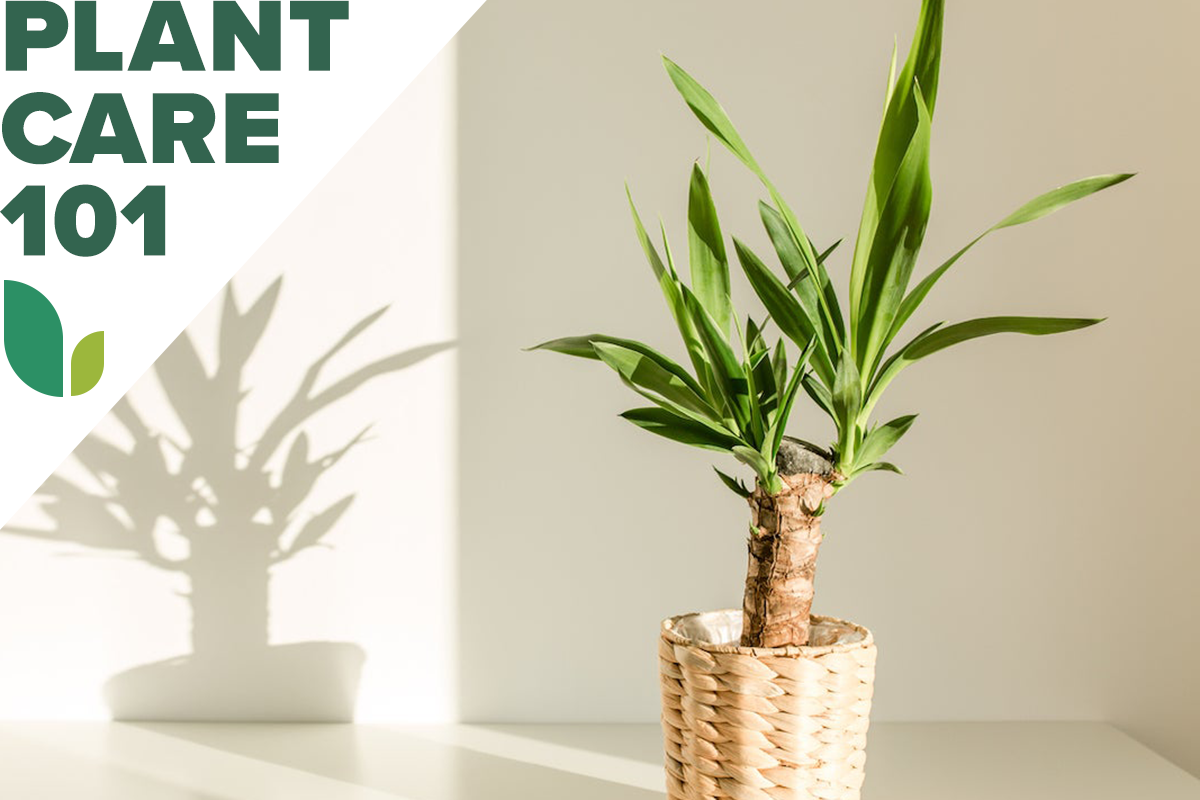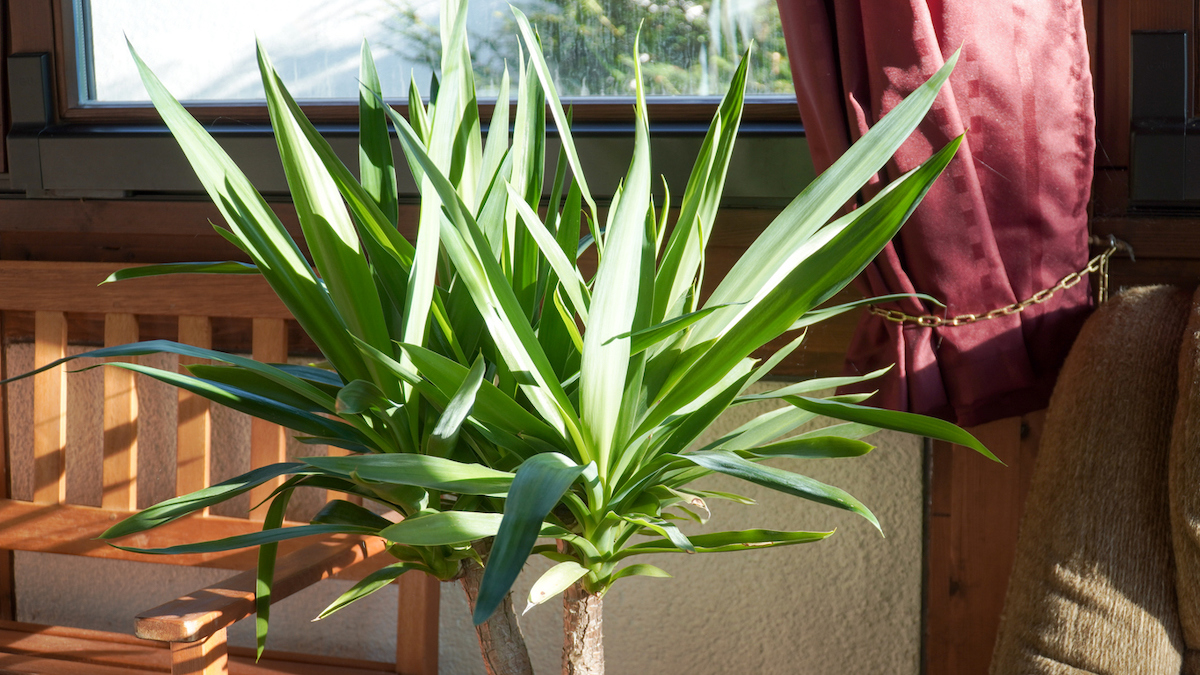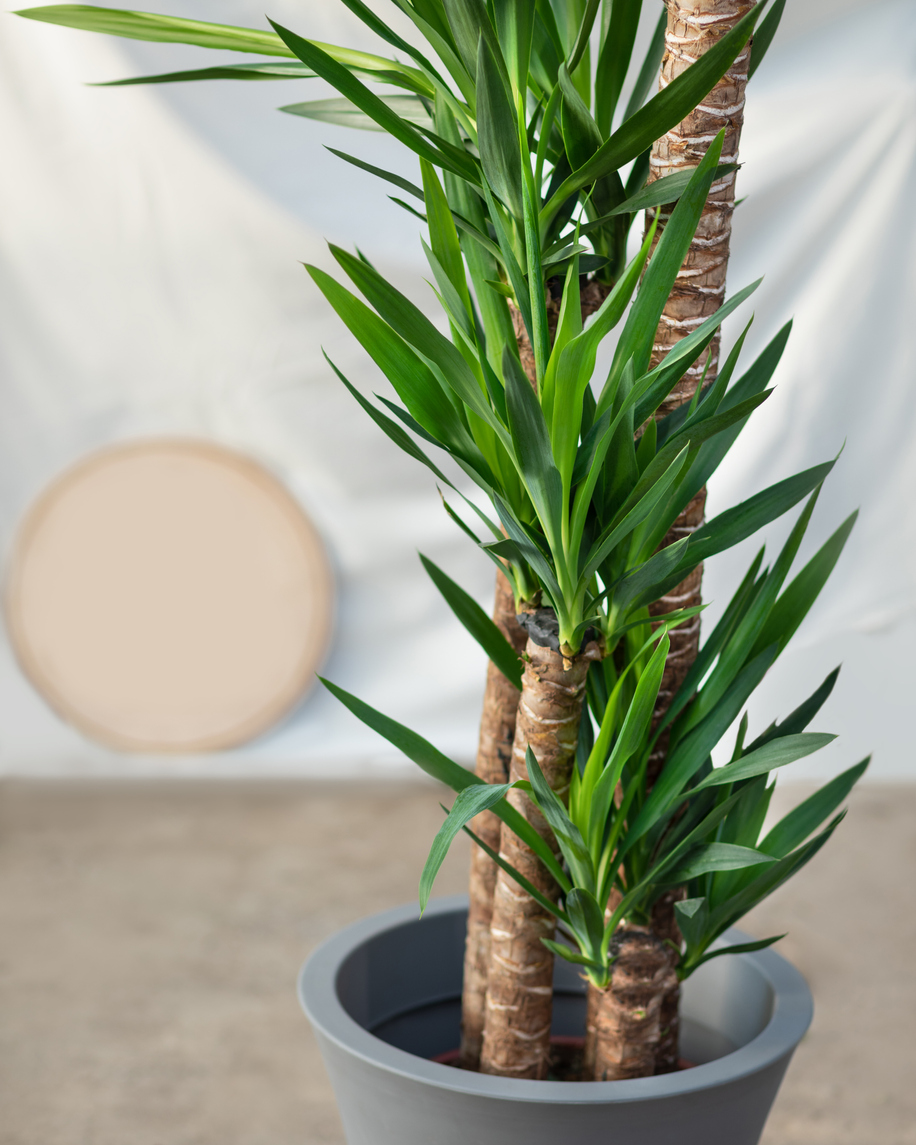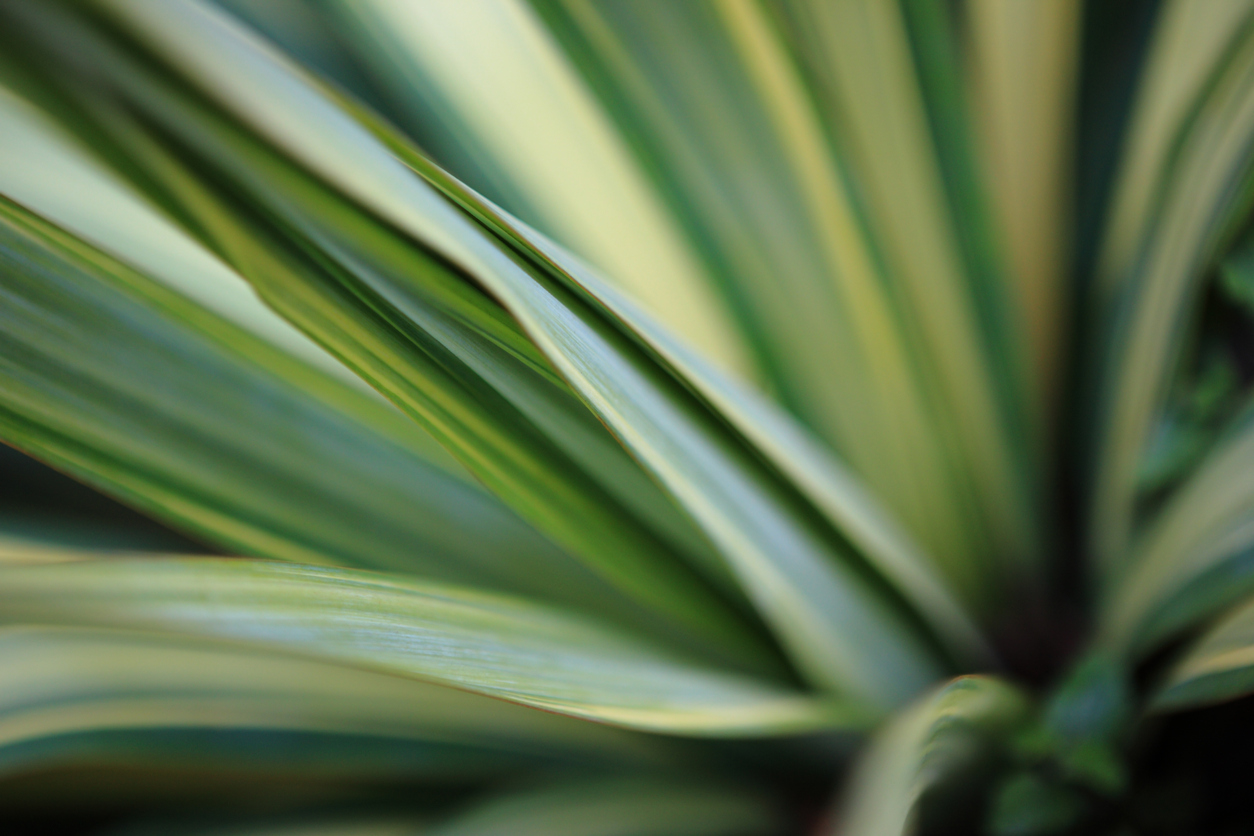

We may earn revenue from the products available on this page and participate in affiliate programs. Learn More ›
When you need a houseplant with height to add to indoor plant groupings, a spineless yucca plant may be just the thing you’re looking for. These tough-as-nails specimens are normally potted in groupings of three to five canes that are topped with blue-green foliage for a palm tree-like effect, but without the drama. Also called stick yuccas or yucca cane plants, they thrive in average indoor growing conditions, with few pest problems.
Thanks to its adaptability, most indoor gardeners can find a favorable location for a yucca plant. For the best results, you’ll need to know a few things about yucca plant care. It’s not difficult, and proper yucca plant indoor care will keep it looking good and growing well for many years.
Yucca Plant Care At a Glance
Common Name: Yucca Cane Plant, Spineless Yucca
Scientific Name: Yucca elephantipes (or Y. guatemalensis)
Soil: coarse, well-draining potting soil
Light: medium to bright
Water: medium
Food: time-release fertilizer, twice per year
Temperature and Humidity: 50 to 85 degrees Fahrenheit, moderate humidity
Propagation: stem cuttings
Safety: moderately toxic, moderately allergenic
Related: How to Help Your Houseplants Survive the Winter
Yucca Plant Characteristics
Yucca plants are known for their tough, evergreen, sword-shaped leaves and large spikes of white flowers. The group includes 40 to 50 species of perennial shrubs and small trees that are native to hot, dry areas of North and South America and the Caribbean. Only one, Yucca elephantipes, is truly suitable for use as a houseplant, thanks to its spineless foliage, manageable size, and compatibility with indoor growing conditions.
Y. elephantipes, also known as spineless yucca or Y. guatemalensis, is a native of Mexico and probably the tallest of all yuccas. In the wild, it grows up to 30 feet tall in a tree-like form. Unlike other yuccas, it lacks spines at the tips of its leaves. Spineless yucca is hardy in USDA zones 9 and above, but in most of North America it is best known as a houseplant.
It features narrow, blue-green leaves up to 3 inches wide and 4 feet long on mature plants. The leaves grow in spiral rosettes. In a landscape setting, white flowers rise on stalks above the foliage in early summer. Container plants stay much smaller and rarely flower.
Types of Yucca Plant
- Adam’s Needle, Y. filamentosa, is a common landscape plant that features attractive exfoliating filaments along the edges of its pointy-tipped foliage, and grows in trunkless clumps 3 to 4 feet tall.
- Spanish Bayonet, Y. aloifolia, a large yucca for warm climates, grows thin trunks up to 15 feet tall and sturdy, thick leaves tipped with a sharp, tough point that can puncture skin.
- Spineless Yucca, Y. elephantipes (also called Y. gigantea and Y. guatemalensis) is the species that is almost exclusively used as a houseplant. Its rugged reputation and spineless foliage make it an excellent low-maintenance choice.

Selecting Soil for Yucca Plants
Indoor yucca plant care starts with lean, well-draining soil. Whatever container you choose absolutely must have drain holes. These thrifty plants do not require a rich, high nutrient mix, but will suffer with too much moisture.
Use potting soil made of coarse organic material and perlite that absorbs water and releases it slowly for the plant to use. Some gardeners amend regular potting soil with an equal amount of perlite for improved aeration and drainage, which works well. Bear in mind, though, that the soil needs to anchor the plant in an upright position. If it’s too light, tall canes can become unstable and might fall over.
Related: The Perfect DIY Plant Stand for Any Empty Corner
The Right Light
Lighting is another important factor in the care of yucca plants. A wide light tolerance is one of the reasons that yucca makes an excellent houseplant choice. It thrives in bright, indirect light, like you’ll find in a room with two or three south-facing windows. In low to medium light, yucca plants will live but grow much more slowly.
As a rule of thumb, yucca should do well in any room with an unobstructed window. However, the less light that streams in, the nearer you should place your yucca to the window. Avoid locations with low-to-zero natural light.
Watering Yucca Plants
When it comes to watering yucca plants, it is best to err on the dry side. Yuccas readily bounce back from drought stress, but consistent overwatering leads to root rot and death. Do not water yucca on a timed schedule. Water when the top half of the soil is dry. When you water, thoroughly saturate the soil to the point of runoff, then discard the runoff.
Related: The One Rule of (Green) Thumb When Decorating With Houseplants
Fertilizing Yucca Plants
Yucca houseplants are quite nutrient thrifty. They require feeding only twice a year, in spring and again in midsummer, with a balanced time-release fertilizer.
For faster growth, it is safe to supplement with liquid plant food at normal watering times. Dilute liquid fertilizer to quarter-strength, and use it to replace plain water. Once a month, use plain water, instead of the weak fertilizer solution, to eliminate any accumulated fertilizer salts that could damage the plant.

Setting the Temperature and Humidity
Of all the factors related to yucca plant care, indoor temperature and humidity are the easiest to provide. Yucca plants tolerate a wider temperature range than many other popular indoor plants. The ideal range is between 65 and 75 degrees Fahrenheit. However, they are perfectly at home at 50 degrees or 90 degrees Fahrenheit. Some gardeners move them outdoors for the summer, while others keep them in cool sunrooms through winter.
In extremely dry air, yucca foliage might turn brown at the edges, but in most homes the air offers ample moisture to keep the leaves looking great. It is fine to mist this plant on occasion, but it doesn’t really need it.
Propagating Yucca Plants
The easiest way to propagate spineless yucca is with stem cuttings. In late spring or summer, use a clean, sharp knife or pruning shears to take a cutting 4 inches below the foliage. Remove any brown or yellow leaves, and place the cutting in a cool, dry, dark place for two or three days. Once a callus forms on the cut end, apply rooting hormone and stick the cutting into a 4-inch pot with a 50/50 mix of potting soil and perlite.
Water the soil and place the potted cutting in an area with bright, indirect light. Roots will begin to develop within four weeks. By the end of two months, the plant should have ample roots so that you can pot it up into a larger container.
Safety Considerations
Yucca presents a few safety concerns that gardeners should keep in mind. The sap and foliage contain a toxic compound that, while not necessarily deadly, can cause serious gastrointestinal discomfort. It affects cats, dogs, and people, so those with pets and young children should beware. Additionally, the sap is allergenic and particles can easily become airborne. If you regularly get the sniffles around plants, this one will probably trigger those sensitivities.

Potential Pests and Diseases
Just when you thought you had a handle on yucca plant care, yellow leaves appear. While yucca is a hardy plant that normally resists most pests and diseases, poor soil conditions or association with infested plants can lead to problems. Follow the best watering practices noted above to prevent root rot. Read on for bug-related solutions.
Spider mites, scale, or mealybugs might invade after traveling from a nearby infested plant. Begin treatment by isolating the yucca and any other infested plants from healthy plants. Clean most of the pests, webs, and egg sacks from the foliage by wiping it down with a cloth soaked in a solution of one part isopropyl alcohol and three parts water. Then treat with an appropriate insecticide for the targeted pest.
FAQs about Yucca Plant Care
If you’re thinking about adding a yucca to your plant family, a few questions might be lingering. Read on for more about yucca plant care.
Q: Is a yucca plant indoor or outdoor?
Yucca elephantipes is a popular indoor plant in most of North America. In USDA zones 9 and higher, it grows well outdoors. In zones 5 through 10, Y. filamentosa is a popular choice for outdoor landscaping.
Q: Do yucca plants need full sun?
Indoor yucca plants prefer bright, indirect sunlight.
Q: How often do you water a yucca plant?
Water your yucca cane plant when the top 2- to 3-inch layer of soil dries out.
Q: Should I cut the dead leaves off my yucca?
Yuccas have adapted to hold their dead leaves for a period of time as protection for younger, more tender parts of the trunk. Outdoors, it is best to leave them until they come off naturally. Indoors it is perfectly fine to remove yellowing or brown foliage.
Q: How long do yucca plants live?
Yucca plants can live for decades with proper care. Give it good lighting, just the right amount of water, and an occasional feeding, and your yucca will be with you for many years to come.
